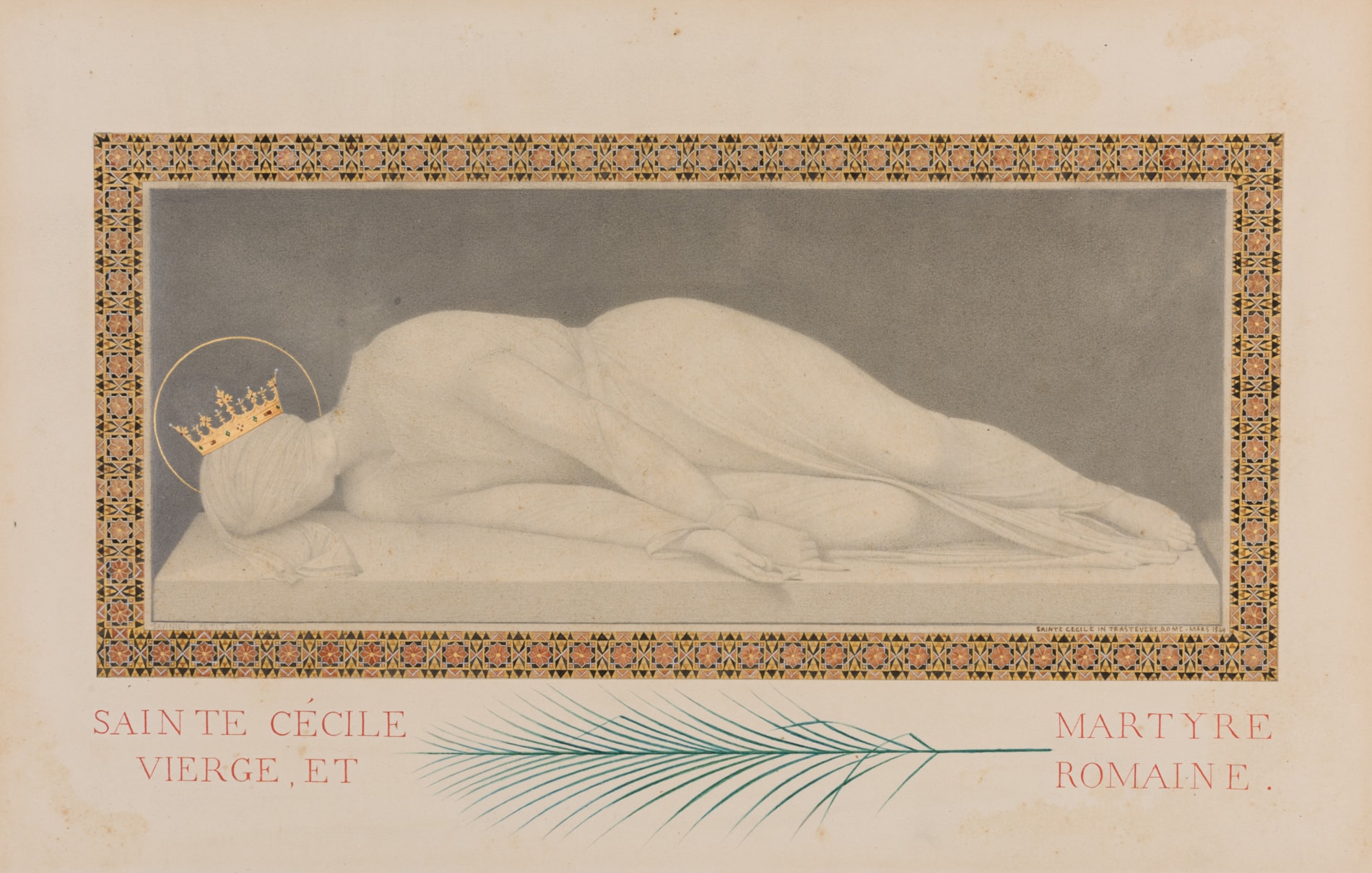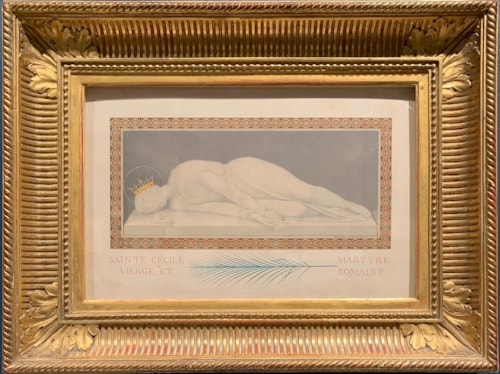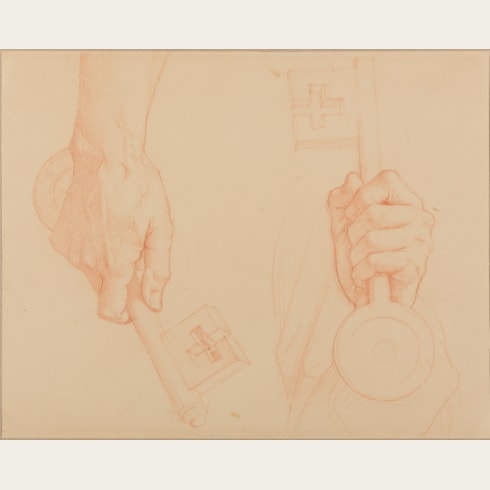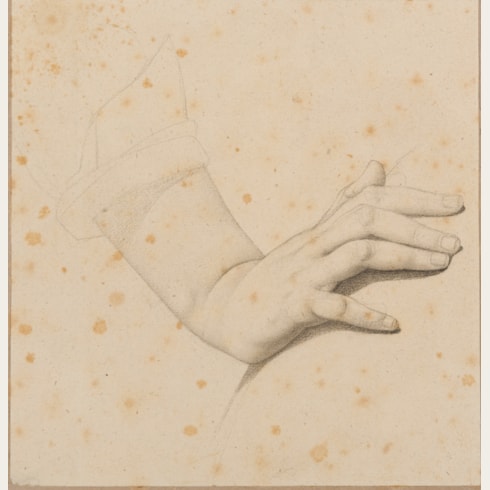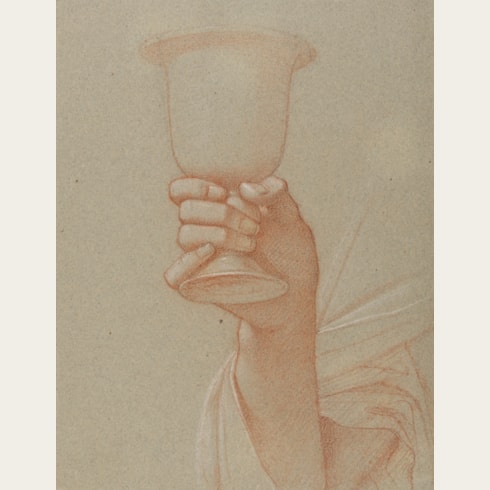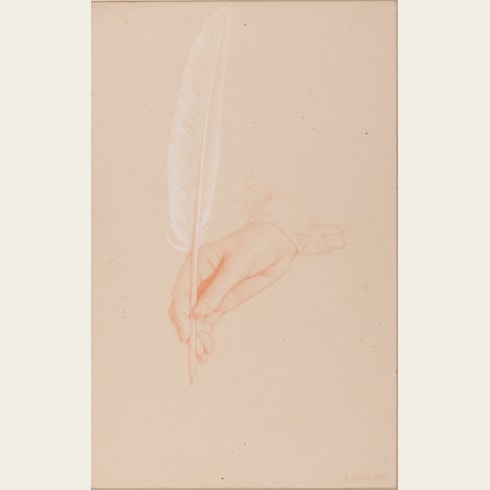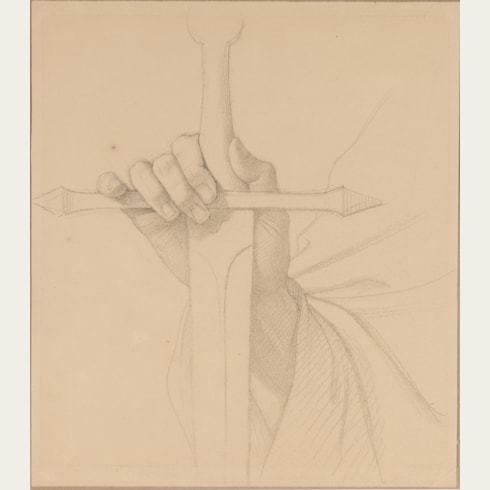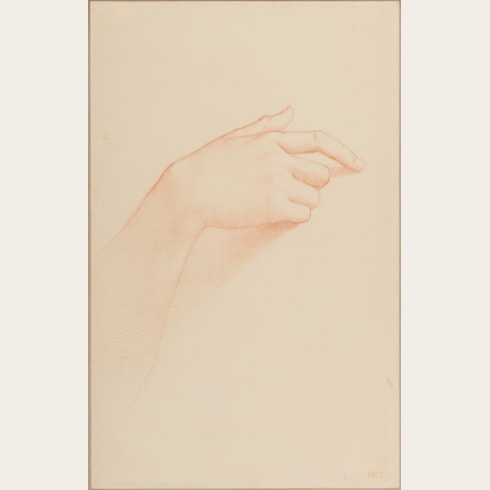Savinien PETIT
(Trémilly 1815 - Paris 1878)
The Tomb of Saint Cecilia in Rome
Signed SAVINIEN PETIT DELT. in the lower left margin.
Inscribed and dated SAINTE CECILE IN TRASTEVERE. ROME. MARS 1849 (over traces of an earlier inscription in pencil) in the lower right margin.
Further inscribed SAINTE CÉCILE / VIERGE, ET/ MARTYR / ROMAINE. below the image.
153 x 333 mm. (6 x 13 1/8 in.) [image, including fictive mount]
259 x 400 mm. (10 1/4 x 15 3/4 in.) [tablet]
Dated 1849, this striking drawing is a copy of the celebrated marble sculpture of Saint Cecilia by the Roman sculptor Stefano Maderno (c.1576-1636), completed in 1600 for the saint’s tomb in the church of Santa Cecilia in Trastevere.
Petit’s earliest surviving painting, a Descent from the Cross dated 1839, is today in a private collection. The following year he showed for the first time at the Salon, with a painting of The Infant Jesus Explaining the Scriptures to His Family, now in the Musée d’Art et d’Histoire in Chaumont. Four years later he won a third-class medal at the Salon of 1844 with another painting of The Descent from the Cross, also today in Chaumont. Although he had never competed for the Prix de Rome, Petit was sent to Italy on a government stipend in 1845, tasked with making archaeological drawings of the ancient paintings in the catacombs of Rome. (These drawings served to illustrate a monumental account of the Roman catacombs by Louis Perret, published in six folio volumes in 1851.) During a period of five years in Italy, Petit worked at a furious pace, making extensive studies of the catacombs, churches and numerous other works in Rome, as well as landscape studies. He was particularly inspired by the work of Fra Angelico, and was also much influenced by the German Nazarene painters working in Italy, such as Johann Friedrich Overbeck, whom he is known to have encountered. It was also in Rome in 1845 that Petit met and married a Frenchwoman, Anne-Alexandrine Pontois, although the couple were to have no children.
On his return to France in 1850 Petit settled in Paris, where he continued to receive commissions from the state for record drawings of buildings and monuments, while also exhibiting infrequently at the Salons until 1870. Although he occasionally produced portraits, he was almost exclusively active as a painter of religious subjects - characterized by a profoundly spiritual manner and a particular purism - for churches, chapels, convents and oratories in Paris and throughout France. Among his first works were his contributions to the decoration of a chapel in the Parisian church of Notre-Dame-de-Bonne-Nouvelle, completed in 1854. Petit’s next significant commission was for the mural decoration of the small private chapel of the Château de Broglie in Eure, painted between 1854 and 1865. The walls and ceiling of the chapel are decorated with scenes from the Old Testament and the Gospels that reveal the distinct influence on the artist of the medieval mural paintings he had studied in Rome. The murals of the chapel of the Château de Broglie, for which the artist exhibited a number of finished preparatory drawings at the Salons of 1865 and 1866, may be regarded as Petit’s masterpiece, and its success led to further commissions.
A large canvas of Christ in the House of Martha and Mary was purchased by the State in 1856 for the church of Richebourg, in the Yvelines département of north-central France, and three years later a companion painting of Christ and the Samaritan Woman was commissioned for the same church, though only completed in 1863. Petit also completed a painting of The Institution of the Adoration of the Holy Sacrament for a private chapel in the home of Mlle. Elisabeth de Mauroy in Paris, exhibited at the Salon of 1857 but now lost. Likewise no longer extant is a painting of The Two Marys at the Tomb, executed in 1858 for the tomb of Prince Mikhail Vorontsov in the Transfiguration Cathedral in Odessa in the Ukraine. (Designed by the architect Eugène Viollet-le-Duc, the Vorontsov tomb was lost when the Cathedral was demolished by the Soviets in 1936.) Between 1860 and 1867 Petit painted two chapels in the cathedral of Saint-André in Bordeaux. For the chapel of Saint-Joseph, he painted three scenes of Saint Joseph in the Carpenter’s Workshop, The Flight into Egypt and The Death of Saint Joseph, for which he was paid a total of 5,500 francs, as well as a Marriage of the Virgin and two large standing figures of Saint Joseph and King David, for which the artist received the same amount in payment in 1868. For the chapel of Notre-Dame du Mont-Carmel in the same cathedral, Petit painted several further scenes, which are dated 1867. Although Petit’s work in Bordeaux was much admired and added greatly to his reputation as a painter of religious decoration, all of the mural paintings for the cathedral of Saint-André are in poor condition today.
The final decade of Petit’s career found the artist still much in demand as an ecclesiastical painter, and a drawing of Saint Joachim was his last submission to the Salon in 1870. A painting of the Magnificat - a rare unsigned and undated work by the artist but listed in the inventory of the contents of his studio after his death - is today in the church of Notre-Dame des Victoires in Paris, while a painting of Saint Philomena, dated 1871, is in the church of Saint-Martin at Pauillac in the Gironde. In 1873 Petit became a member of the Société de Saint-Jean, founded the previous year with the aim of promoting the practice of Christian art. Among his last major projects were mural decorations for the apse of the church of Saint-Gervais-Saint-Protais in Rouen, painted in 1875 and depicting six standing saints on gold backgrounds, and a painting of The Sacred Heart for the Parisian church of Saint-Joseph, commissioned in 1870 but only completed in 1876. A commission for frescoes to decorate the chapel of the Franciscan convent on the rue de Fourneaux in Paris, for which a number of preparatory drawings survive, was barely begun before Petit’s death in February 1878. Three months later, the contents of his studio were sold at auction in Paris, and dispersed.
Although Petit had been honoured in 1860 by Pope Pius IX as a knight in the pontifical order of Saint Gregory the Great, by the time of his death he was relatively little known, apart from the fellow members of the Société de Saint-Jean, whose secretary, Pierre Depelchin, published a thorough account of the artist’s life in the Revue de l’art chrétien in 1878. Depelchin praised Petit’s work but noted that the artist’s almost complete lack of ambition meant that his oeuvre was underappreciated in his own day. Indeed, not long after the artist’s death his name and reputation had fallen into almost total oblivion. The first comprehensive modern study of Petit’s career was only published in 2003, and his work remains rare today. The artist’s paintings are not represented in most museum collections in France - apart from the Musée de Picardie in Amiens, the Musée d’Art et d’Histoire in Chaumont and the Musée d’Art et d’Histoire in Langres - and are almost completely unknown outside the country.
The May 1878 sale of the contents of Petit’s studio included 83 paintings and oil sketches, 33 large finished drawings, and ‘a good number of drawings in various pencils, very well finished, and used for large paintings’, together with fourteen cartons of diverse drawings, classified by subject matter. His work as a draughtsman remained almost completely unknown, however, until a large cache of his drawings was discovered in an antique shop in Lille in 1977. The two largest extant groups of drawings by Petit are in the Ecole des Beaux-Arts in Paris, which purchased over three hundred drawings - mainly copy drawings made in Rome - from the artist’s estate in 1878, and the Musée des Beaux-Arts in Nancy, which owns a more complete and varied group of around two hundred and sixty sheets, many of which were included in an exhibition of the artist’s drawings at the museum in 2004. A handful of other drawings by Petit are today in the collections of the Musée des Beaux-Arts in Bordeaux, the Musée des Beaux-Arts in Dijon, the Louvre in Paris and the Prado in Madrid.

